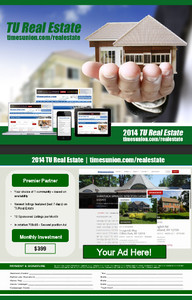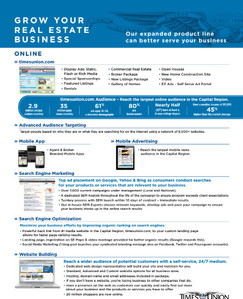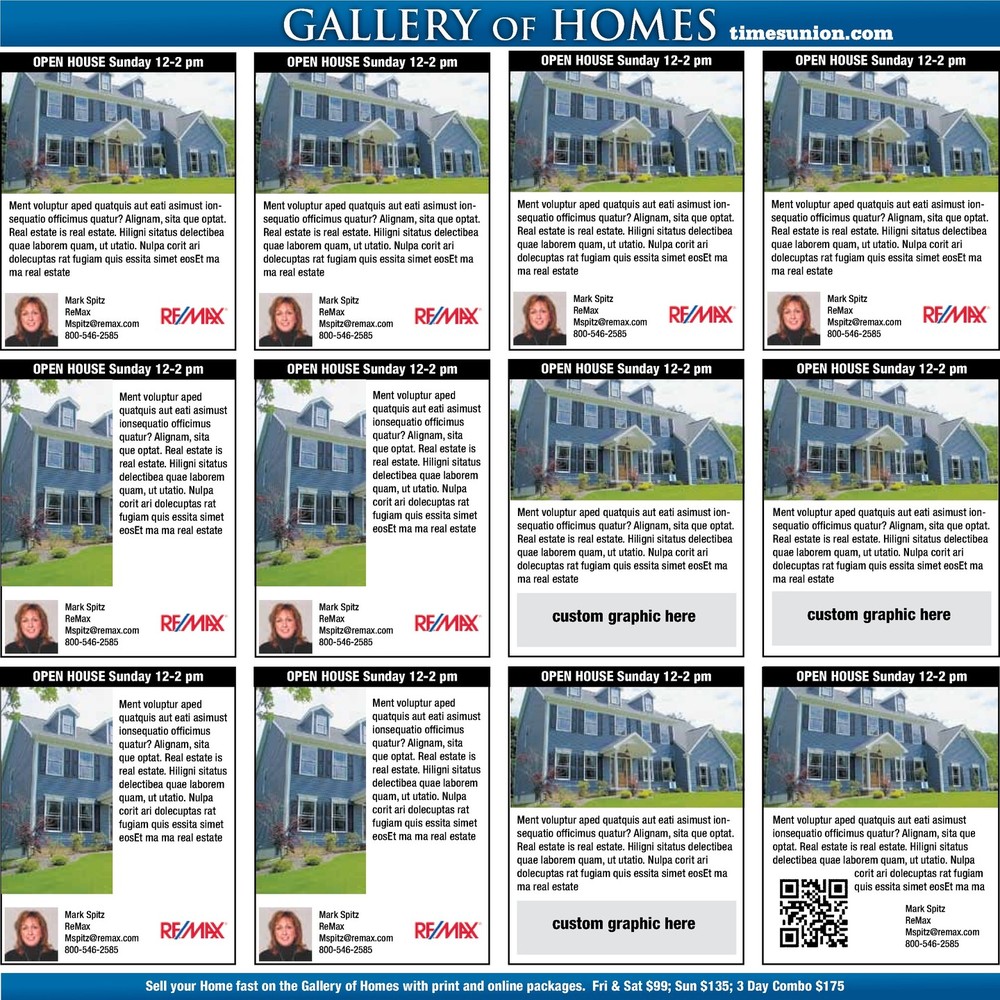How the Albany Times Union grew real estate revenues
Three main initiatives by real estate manager Kevin Warren are paying off in 2015
Media: Albany Times Union
Owner: Hearst Communications
Market: Albany, New York
Population: 60,000 with a DMA of 1.1 million
Initiative: Real estate
Key Executive: Kevin Warren, Real Estate Advertising Manager
Objective: When Kevin Warren took over the real estate division of the Albany Times Union, advertising in the segment had been in a four year decline. "My goal was to stop the bleeding and get the department going by maintaining print ROP while growing digital revenues."
Strategy: With these two key goals in place, stabilizing print while growing digital, the first step was an assessment of and business plan for the department. The new strategy had three overall components: 1. Designing new print digital packages to sell media-owned assets; 2. Adding additional digital products and services; and 3. Executing a marketing plan for self-serve options.
1. Designing new print/digital packages
A few of the first changes in the pricing and packaging method included:
• Replacing separate rate cards for print and digital with a new rate card that combinea print and digital and mobile into packages that run 13, 26 and 52 weeks.
• Adding Run-of-Site impressions to packages to improve the overall traffic level of real estate banner ads. Merely running ads, agents and brokers in the search-oriented real estate channel did not deliver substantial traffic, so including a share of the massive run of site traffic delivered the clicks advertisers wanted.
"With a decent CTR, we had a good story to tell when we upsold larger packages," Warren said.
• Creating more compelling calls to action for real estate ads. Some ads utilize an image of a classic Victorian home for $150,000 or $200,000 as a "low leader" that appeals to home buyers' imagination. Another realtor offered an instant home valuation to help capture e-mail addresses of people who are potentially interested in selling their home. Whichever strategy was used, the team's expertise in designing creative that "works" grew.
After a few months the company was starting to show success - breaking even year-over-year. Within six months revenues began to grow, and from July to the end of 2013, the revenues took off, fueled by anincrease of 137% in digital. A sales deck to help print reps sell the digital component of packages is attached above - Warren says that reps were much more comfortable with print, so these visual tools aided in the field. A sample page from the deck is below:

2. Adding new digital products and services
Once real estate revenues were on the increase and "we showed we can do a good job selling our own website," the team began to sell digital packages that included advertising elsewhere on the web and other digital products.
Added to the suite of services:
• Dynamic SEM retargeting
Using the Kenshoo platform, the company began making PPC purchases with dynamic SEM retargeting using the Kenshoo platform. Ads were served based on zip code within a ten mile radius. Kenshoo allows the user to set-up criteria to drive the ads, such as search on homes or anything related, and build the buy for every key word in that geo, retargeting users who click.
• Network retargeting
Warren used a company called Recrue to set up its targeting and retargeting by creating custom networks. "We had home manufacturer who had a campaign not working, they built it out and it was a success, so we started using them."
Pricing for the packages ranged from $499 to $2,500 per month or custom. The most popular for brokers is a range of $800 to $1,000 no more. Print was a component in one form or another. If they were on print contract, they received a reduced rate. If the spend was $1,000 in digital, they would "match it back" giving them $1,000 value in print.
"Some clients say print's dead. Some young brokers say their clients want their homes marketed in the newspaper," Warren says.
"Everyone was different....Coldwell Banker locally advertises themselves and their new construction sites. RealtyUSA only markets their name. Another brokerage advertises its resell properties. Most brokers don't focus on the agents; they leave it to the agents to market themselves."
In 2014 the team sold 25 to 30 or more of these packages. Print was a component in some form or fashion - either print, adding on the digital, and matching space back. If they were not given a dramatically reduced rate.
• Claim, cleanse and post
Another successful product is general presence services including some claim and cleanse, social media posting.
“We talk to them about SEO SEM to promote themselves; our service includes claiming the google plus page, Facebook page, LinkedIn profile, YouTube and posting regular. If they take pictures, putting them into a YouTube video and on their website helps them outrank Trulia and Zillow.
• Website development
Hearst entered into a partnership with Boston-based Placester.com, its first media contract, to develop specialized websites for real estate agents. The Times Union now sells these agent websites for $5 a month, basically a low leader Warren says, "to get a foot in the door."
Placester basically is automated building of 12 or more all real estate-oriented Wordpress templates. “The hardest part is getting the IDX feed into the website and inputting your information and verbiage. They look pretty good.” After just 90 days into the partnership, a dozen are already sold.
Below is a one sheet of new digital services:

3. Marketing self-serve ads
The third component of the real estate turn-around plan was self-serve posting. A self-serve advertising platform was already in place, but rarely marketed. To create a real marketing plan, Warren tapped a list of realtors from the MLS, then began e-mailing packages and specials available via the self-serve portal, a platform created by Wave2Media, to sell two products, a Gallery of Homes and EZAds listings.
The first email, promoting print listings goes out on Monday night, and the the second for Gallery of Homes packages, goes out on a Friday.
Gallery of homes is a pictorial gallery of higher end open houses that runs both in print and online. The real estate team pulls the list of open houses every Monday, identifies homes worth more than $300,000 and sends them an email offer: Feature the home on the real estate website for seven days, and run it Friday, Saturday and Sunday in print, for $189 (take that Trulia!).
Here's what the online promotion looks like:

Followed by the printed Gallery of homes:

Since e-mail marketing began, the print section alone grew from one page to four pages, "100% self-service."
Print listings upsells are print only, in-column line ads, and marketed separately to agents and borkers in a Monday email.
Typically ads ran in the range of 400 to 500 on the weekend, but with the email boost, lineage goes up to 1,500 to 1,800 ads.
Other kinds of marketing for self-serve include sales sheets taken out by reps and numerous visits to real estate offices to train agents and increase their comfort level with using the self-serve tools.
"We showed them how to place an ad, what it looks like after-words, how to enter their credit card information, and where to call with questions."
Since the two main competitors are "unquestionably" Trulia and Zillow, the pricing and packaging is specifically positioned to be compete with them and to pick up realtors priced out of those options.
"We talk about the traffic to our website generally. We have 40 million page views and two million unique visitors, making the TimesUnion.com the third largest media in the area after Google and Facebook. Zillow and Trulia are not even in the top ten."
"If we have the audience - and we are cheaper - it makes a lot of sense (to buy newspaper packages.)"
"We have a package to allow realtors to feature all their properties on line - from 0 to 10, 11 to 20, 21 to 35 and 36 plus, for $199, $399 and $499 respectively, or $25 for an individual home.
"So for a flat rate they can feature all their properties, which allows them to run in the right hand rotation. It's considerably cheaper than Zillow," Warren said, which would charge $2400 or more for a similar service.
All told, 2015 sales are projected and tracking 35% more than 2014 and total digital sales have grown from $18,000 $20,000 a month to $45,000 to $50,000 a month.
Many thanks to Kevin Warren for sharing his field-tested expertise with our members.

Kevin Warren, director digital sales, Albany Times Union
Media technology (click to find the contacts) used includes:
Wave2Media
Placester.com
Kenshoo
Recrue









